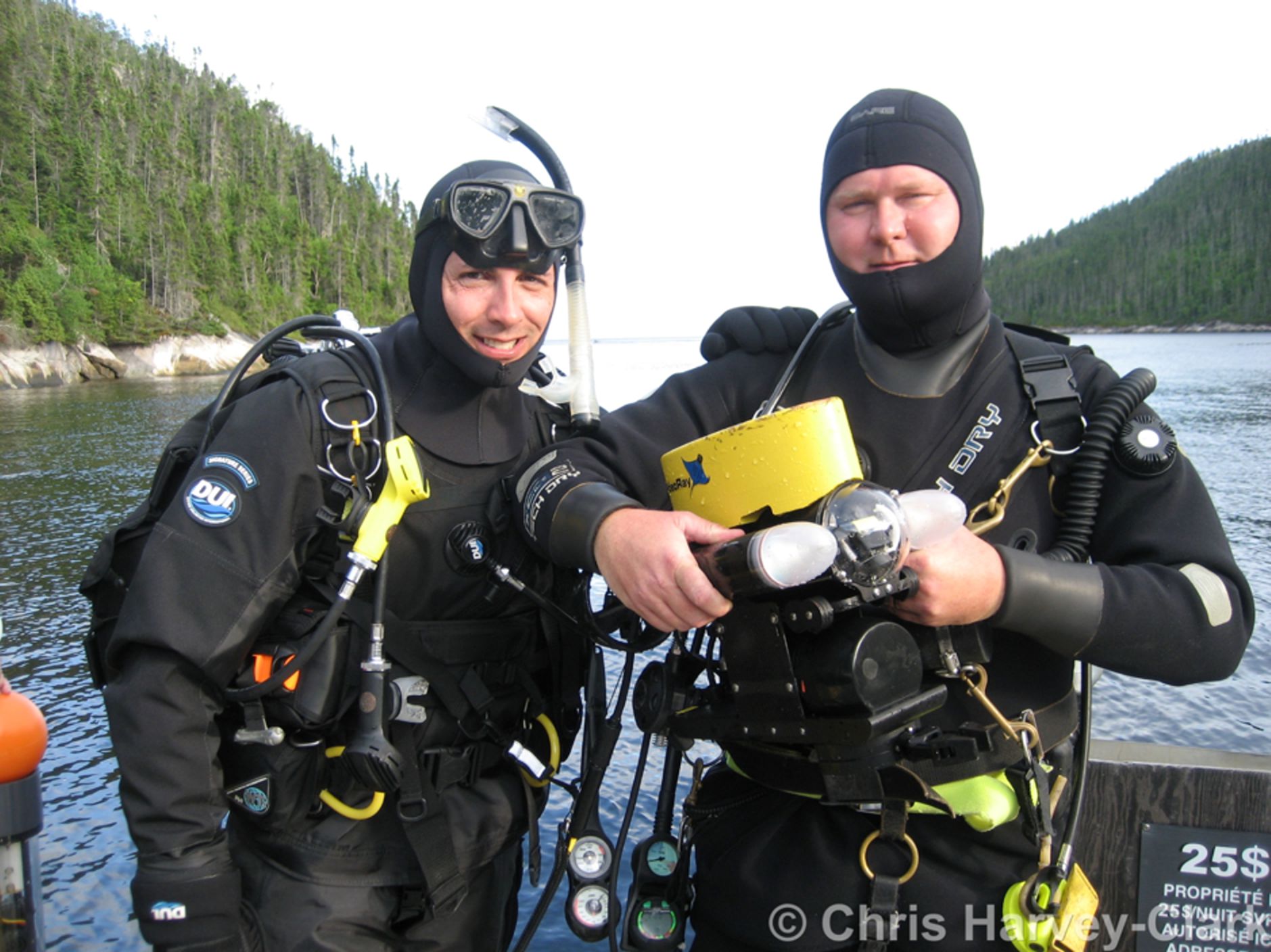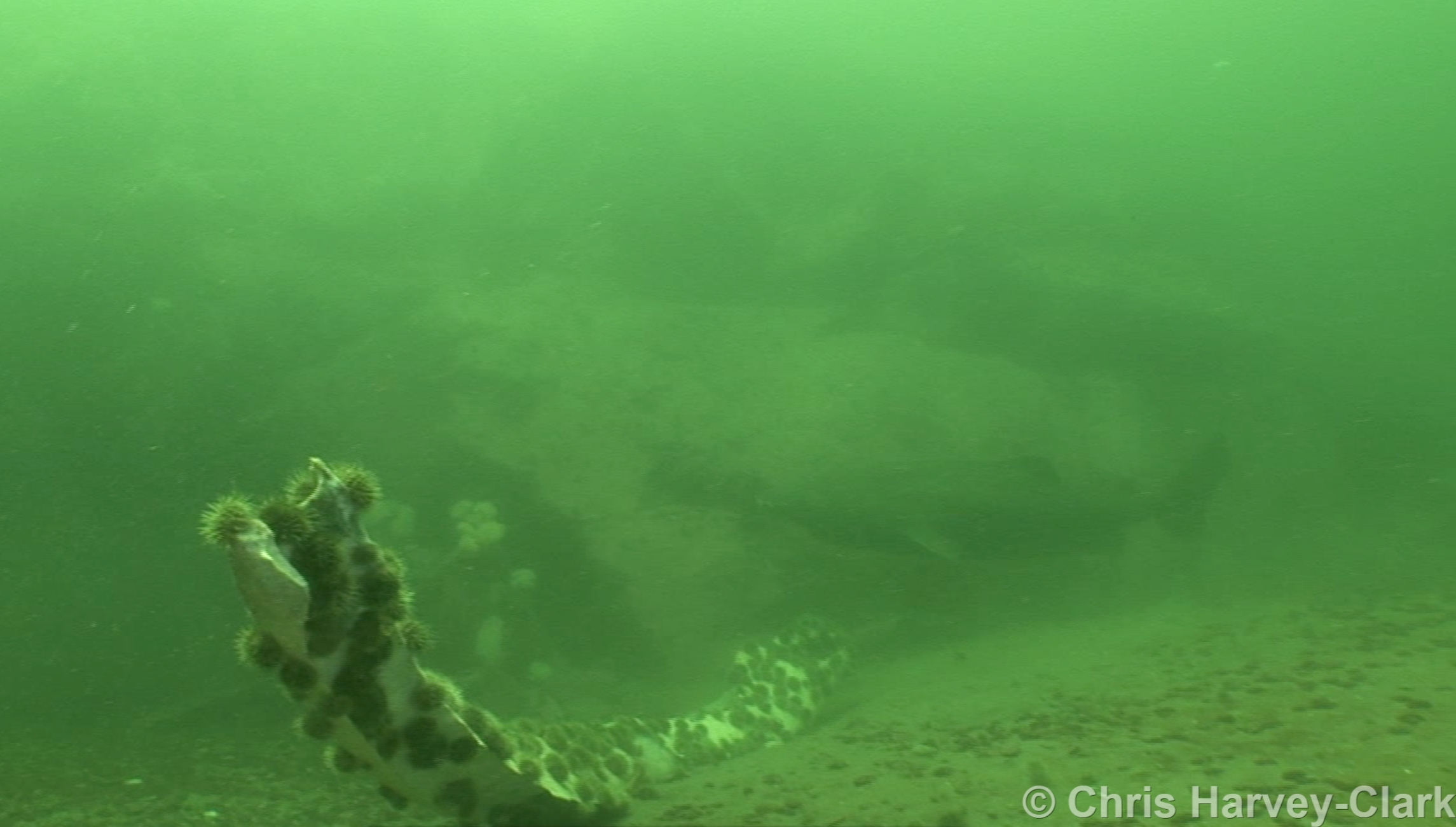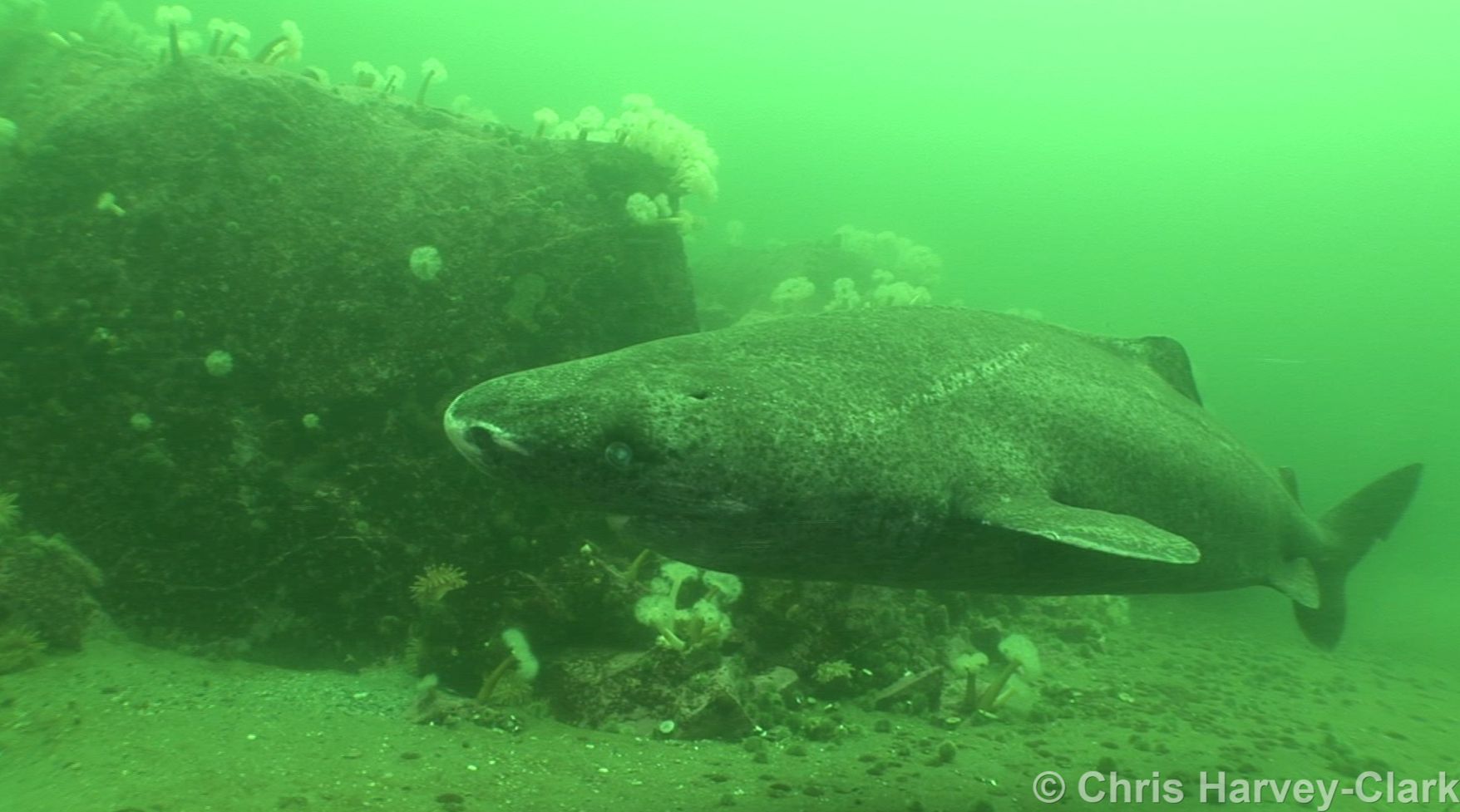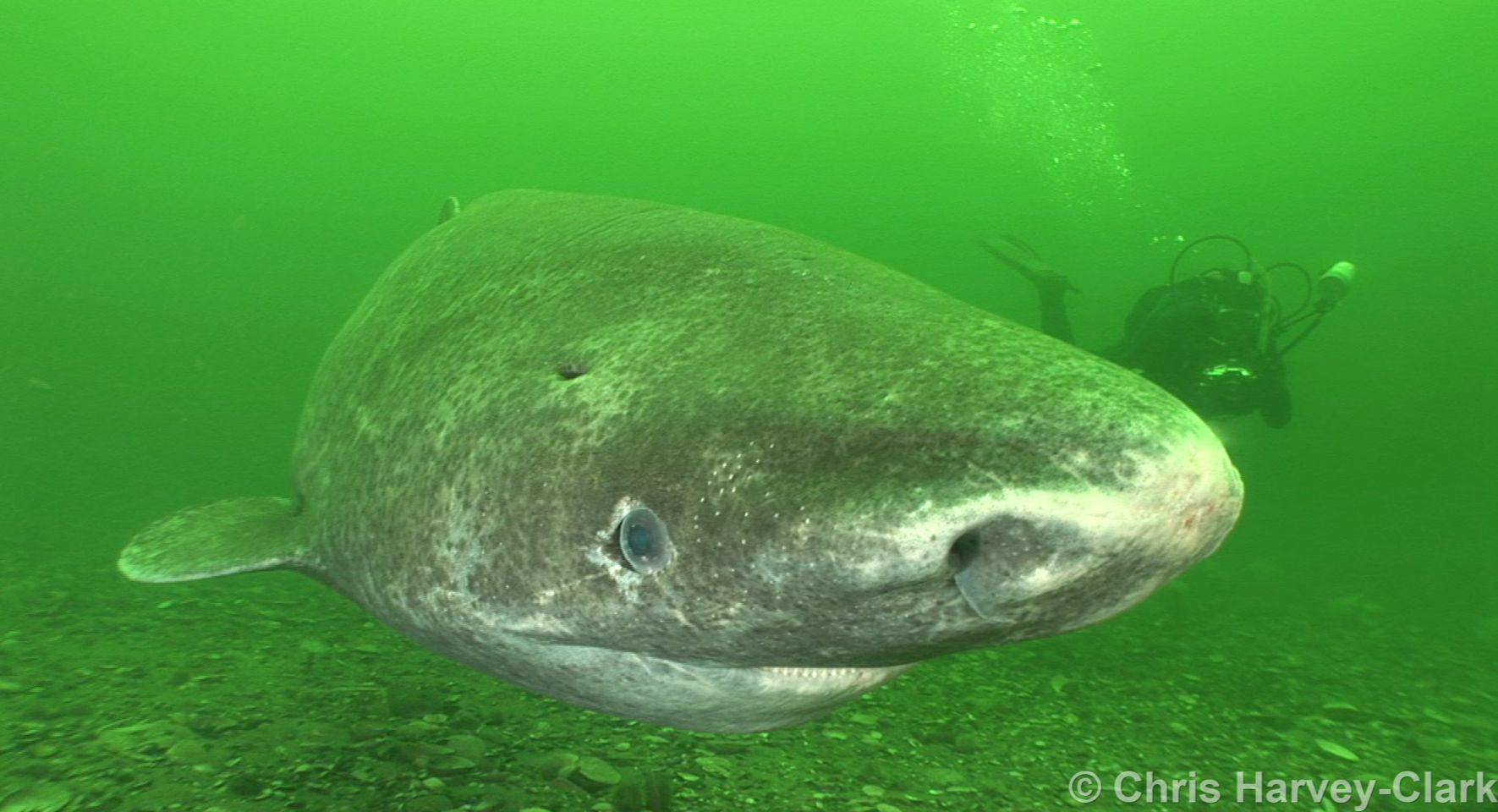Part 1: Finding the monster
John Steinbeck famously wrote in his book Log from the Sea of Cortez that “an ocean without its unknown monsters would be like a completely dreamless sleep.”
In the 21st century the planet we inhabit seems to be shrinking under the weight of humanity, with fewer secrets and fewer monsters, and yet mysteries still beckon, particularly in the ocean.
The Greenland shark, Somniosus microcephalus, is one such mysterious monster, little studied until very recently, a giant deep sea shark that has captured the imagination of scientists and laymen for the last century or more. William Scoresby, the 19th century whaling captain/naturalist illustrated these alien creatures as they appeared in their hundreds, feasting on the bowhead whales being butchered at the side of his vessel in Arctic waters. Scoresby drew some of the earliest scientific illustrations of this species showing their characteristic attached eye copepod parasites, which he misinterpreted as part of their normal anatomy. These bizarre, zombie like sharks are extremophiles; living at the extreme of many spectrums : at 6.8 meters and 1,400 kilograms they are the second largest carnivorous shark after the Great White, inhabiting depths in excess of 3,000 meters and swimming under the polar ice cap in water as cold as minus 2°C. They are likely the longest living vertebrate animal on the planet. Their family name, sleeper shark (Somniosidae) is enigmatic; so named for their slow moving , sleepy habit and yet found with seals and cetacean remains in their stomachs. A species that has been caught in tens of thousands, and yet accurate anatomical descriptions are lacking; remaining largely unknown to science. Many unanswered questions exist regarding this creature with an unequalled ability to adapt and thrive in the most harsh, extreme environment on the planet.
The beginning of an obsession
The Greenland shark first captured my imagination at an age when kids are intrigued by sharks and sea creatures. Our local newspaper in Ottawa, Canada had a winter photo of a Quebec ice fisherman in the St Lawrence river, not far from where I lived , with 2 big sharks laid out beside his fishing hole. How amazing to be a shark, an animal usually associated with the tropics, and to live under ice ! The caption indicated the sharks were “bull sharks”, but even as a child I knew the tropical range of that species . Comparing the pictures to illustrations in reference texts I concluded that the fisherman had in fact caught a pair of Greenland sharks, normally only found in the Arctic, and so my obsession with these odd animals was born at an early age.
In 2003, having spent 5 years chasing old newspaper and “grey literature” accounts of Greenland sharks being caught by ice fishermen in northern Quebec, myself and colleague Jeffrey Gallant were very fortunate to be the first scientists to spend many hours over many years underwater, literally at times eye to eye with Greenland sharks under natural circumstances. It is perhaps the greatest privilege as a biologist to encounter and document the lives of unknown animals, first hand. The road to these encounters was long, arduous, and highly exploratory because there was no road map or scientific literature on the species, particularly in the region where we were looking, the outer St Lawrence River in Northern Quebec, Canada.

From 1998 to 2002, we chased clues and apocryphal accounts, which led to arduous mid winter underwater expeditions to the Saguenay fjord region of Quebecs north shore. Here, we knew from old newspaper accounts and oral tradition in the local French dialect, the sharks had occasionally been caught by ice fishermen. Diving through many feet of ice, with surface air temperatures as cold as minus 42°C, into pitch black current swept 2°C water, we chummed and used ROVs as well as scuba to seek the sharks. The search went on in the vicinity of fishing camps where rumors and old photos indicated these sharks had been caught. Diving here under challenging circumstances, we risked our lives tethered to the surface, expending our energy and personal fortunes, but sharks remained completely elusive.
The first encounter
By 2003, no sharks had been caught by ice fishermen in the region for a decade, and we had no luck finding sharks, so we reluctantly gave up the hunt. It was then that fortune smiled. In May of 2003 a commercial diver encountered a large animal while working on a dock underwater at a site near the town of Baie Comeau, Quebec, on the outer reaches of the north shore of the St Lawrence Seaway where it becomes part of the North Atlantic Ocean. The giant shadow he saw passing by in the greenish murky water was curious and came by several times before its bulk disappeared for good. The diver was unsure of what he had seen, but noticed that the big tail was vertical, not horizontal. He concluded that the creature must be a shark. Hearing of this encounter I was at the site, a remote bay called Baie St. Pancrace, within 48 hours, excited at the possibility of finally finding an animal I had sought for so long.
The water in the bay was freezing, dark and murky as we stood on the dock in the late May sunshine, preparing for our first dive. The ocean was alive with predators feeding on enormous schools of capelin (Mallotus villosus), a small bait fish; grey seals (Halichoerus grypus) were feasting everywhere, and minke whales (Balaennoptera acutorostrata) were lunge feeding a few feet away from the dock on this bounty of fish. Donning drysuit gear, I dropped off the dock into the greenish water and rapidly descended to the bottom at 20 meters, swimming out towards the mouth of the bay. The visibility on the bottom was 6 meters or so. Within a minute of descending, out of the green gloom, hovering a few feet off the bottom, a huge dark shape materialized, slowly swimming towards us on an oblique course.

As a scientist, when you have spent half a decade looking for a rare animal and have come to the conclusion you will likely never find it, to then suddenly encounter the living creature face to face is a life-defining moment. When that animal is a 4 meter shark, ghoulish in appearance, and when you have no idea whether it wants to eat you, there is a certain edginess to that moment. The shark, not moving a muscle, gliding over the sandy bottom, slowly drifted past us at a speed of about 20 cm/second. It seemed aware of us, but detached, almost in a trance like state. A majestic, slightly menacing presence, and I noticed the large eyes swiveled as it went by, changing course to track us. I moved closer, swimming parallel to avoid losing it in the gloom, and the enormous, paddle like tail began to slowly thresh the water. With barely an effort the shark accelerated towards deep water and it was all I could do to keep up. Camera rolling, flood lights on I recorded this first encounter, with a surreal feeling enhanced by nitrogen and cold. The shark was a large male, missing one of its claspers (male sexual organ) while the remaining clasper looked well used and calcified, a sign of sexual maturity and age. This shark had effective camouflage, with a dark head and mottled grey colored body. He was covered in scars, some of them linear, especially around the tail, and on the flanks of the body. The sensory lateral line running along the animal’s side had a distinctly dorsal location, which was dissimilar to what I had seen in scientific illustrations of the species. I could see the small respiratory opercula on the upper side of the head behind the oval eye, and the gill slits rhythmically opening and closing. With my nose a few inches from his flank, I studied the skin surface, and the dermal denticles were so large they were individually visible, like protruding thorns. The large pores of the Ampullae of Lorenzini, the electroreceptor system of the shark, covered the nose with holes big enough to stick a pencil in, belying a significant ability to hunt using electroreception which could be a distinct advantage in low visibility and in the absence of light. Briefly I strayed too close to the sharks head and he depressed his pectoral fins, turned away and the tail came up off the bottom. The shark, momentarily halted, held this strange nose down posture briefly, then resumed normal swimming. This puzzling behavior was likely an agonistic display which I was to see many times over the next decade in response to close approach, and which preserved some elements of agonistic displays seen in other shark species .



By now I was running low on air and in 30 meters of arctic water. I looked at my pressure gauge and only a few minutes of air remained, not enough to retrace my route to shore but enough to get me to the surface with a mandatory safety stop first. Reluctantly I said a mental farewell to this, my first living Greenland shark. I felt profoundly thankful for the encounter and regretted that it had to end. I began to ascend towards the surface, rising above the shark and scanning around the water column. Incredibly, at the extreme of visibility towards deep water, I saw the unmistakable outline of another shark in the distance. This seemed too amazing to be true! To find two of these rare animals on the first dive just seemed like incredible luck, after years of searching. As I hung at 4 meters on my safety stop decompressing, my mind was reeling with possibilities; perhaps this site was experiencing a never before documented shallow water aggregation of this rare animal; if so, why were they aggregating?
I ascended to the surface, feeling jubilant. At last I had found a secret lair of the Greenland shark, and even in the excitement of the first dive, new observations and questions that could only come from a field encounter were crowding my thoughts. There were multiple sharks at this location - what was attracting them? Why had no one seen this species at this location, with 30 years of local diving prior to the sightings? And most intriguingly - how is it that these sharks lacked the blinding copepod parasite affecting the eye that was ubiquitous in the Arctic Greenland shark population, infecting nearly 100 percent of the animals and rendering them essentially blind?

The shark I had seen actively avoided us visually, appeared to be able to see us, and in subsequent observations we were able to document sharks actively changing course to avoid divers when they caught sight of us underwater, as well as observing that the eyes swiveled to keep us in sight as the animals swam past.
What effect could possessing the ability to see have on the ecology of this species, particularly feeding behavior and predation? Did it relate to the way these slow moving, seemingly lethargic animals capture fast moving, large brained prey like seals - or did they simply scavenge dead carcasses? Why was the lateral line placed so dorsally in this species - could it be an adaptation for detecting acoustical input from prey in the water column?
The possibility of working with an animal so rare that few accurate images existed of the species in natural conditions was a compelling research opportunity. This species was so poorly known that there were errors and omissions in the species accounts and illustrations in reference books. With no tools immediately at hand to study the animals other than observation and a video camera to record the encounters, I remained at the site for the next 2 weeks. Over 12 days I saw several more animals, including a huge female shark 4.5 meters long that was intimidating in her speed and purpose as she rapidly swam past in 30 meters of water. Again and again the sharks appeared out of the gloom, as if attracted to divers. I documented many intriguing features during this first series of memorable encounters, some lasting as long as 20 minutes . It seemed the sharks were curious about us, would often swim out of sight and then reappear from a completely different direction, often behind the divers, consistent with curiosity, perhaps stalking behavior.

Then, as abruptly as they appeared, the shark sightings ceased for the remainder of the summer of 2003. Despite a concerted effort with the help of local volunteer divers we did not see sharks again that season in some hundreds of dives.
Beginning the work in earnest
Encountering Greenland sharks at last was like striking gold after years of fruitless prospecting. Following these initial encounters, over the winter of 2003-2004 I initiated a research project to study the Greenland shark under the unique natural circumstances in Baie Comeau. The sharks were visiting shallow depths at this location for unknown reasons. At that time it was still common practice in fisheries biology to study poorly known species by the tried and traditional methods known as catch'em, kill'em, cut'em up. These methods have been practiced for thousands of years, from the time of the earliest naturalists like Pliny the Elder and Aristotle, and continue to be a staple approach in the study of fishes. While allowing for rapid evaluation of normative biology like stomach contents, gender, age and sexual maturity, the insurmountable disadvantage is that the animals must be killed. However, this aggregation of sharks was so unusual that I was unwilling to follow this pathway for ethical as well as science based reasons. If the sharks were a small localized population, conventional methodology could simply extirpate them, leaving nothing to study. In latter years this decision has proven correct and has been supported by other researchers, for instance in studies of Great hammerhead sharks, Sphyrna mokarran . More fundamentally, these conventional approaches placed little value on the living animal. My decision to employ non lethal approaches was also based on a suspicion that these sharks might be very old indeed, based on a single study that had estimated their growth rate at 0.5-1 cm per year . How old was a 4 meter shark? Perhaps hundreds of years old.
I resolved to study the sharks in as non invasive a fashion as possible. Even catching the sharks with hook and line was out of the question. Having seen many sharks suffer lethal damage by deep hooking and damage to the jaw cartilage by angling, despite the challenges, I resolved to study this shark aggregation using scuba diving, recording video observations and using telemetry methodology to track movement, behavior and environmental preferences. That winter I obtained and learned to use basic acoustic telemetry equipment. This equipment, made by Canadian manufacturer VEMCO, placed acoustic pingers on the animals using a small dart tag attachment and gathered data on their movement and behavior using an underwater bottom deployed receiver system. I built a simple device that allowed me to project green laser dots onto the sharks while videotaping, providing a ruler to accurately measure their length underwater. Now I could measure, define the sex, record the behavior and track the movements of the sharks while minimizing disturbance.
With tremendous optimism, in the spring of 2004, on the anniversary dates of the first observations of Greenland sharks, a well organized team of scientific divers descended on the region and systematically combed the bays and fjords of the northern St Lawrence region. The hydroacoustic telemetry transmitters and receivers I brought would send coded signals from the tagged sharks identifying them, indicating location, depth and the water temperature. Using this gear we hoped to get an idea of the large scale and fine scale movements of the sharks, to begin to unravel the secrets of their natural history. Now all we had to do was find the sharks.
Locating sharks proved to be highly challenging. For weeks the spring weather was fierce and the wind blew ceaselessly from the south across the St Lawrence River, while it rained incessantly. The chocolate brown, tannin rich river water flowing from the thawing landscape of northern Quebec colored the ocean a deep, dark hue and reduced visibility to a few feet, effectively shutting out light as well. The surface water that piled up on the north shore of the St Lawrence was also much warmer than the sea water - up to 14°C while we were accustomed to bottom temperatures of 2-4°C in this region. The dive teams methodically scoured the bottom for more than a week, making dive after dive around the three bays where we had seen sharks previously, but none were found.
By the final day, the team had reluctantly come to the conclusion that the sharks were elsewhere. I had some dark thoughts that the previous years sightings were a unique, once in a lifetime event, never to be repeated. Tired out by a week of strenuous diving under adverse conditions, I reflected that those few days in the spring of 2003 might be the only time in my life I had the privilege of briefly opening the window of first hand observations revealing the alien world of the Greenland shark.
A moment of enlightenment
On the final day, cars packed, ready to catch the ferry back to the South shore of the St Lawrence for the journey home I resolved to do one more dive to document unusual numbers of snow crabs (Chionocetes opilio) aggregating in their thousands in shallow water, possibly breeding. After the fruitless week and dozens of dives, the chances of encountering Greenland sharks had been reluctantly dismissed by all.
Anchoring the support boat in a shallow bay off a fast flowing river black with freshwater runoff, I jumped into 5 meter water that was the color of coffee. With visibility down to half a meter I immediately lost my dive partner, although I could hear his scuba regulator regularly releasing compressed air nearby underwater. I settled on the bottom, looked down at my camera which was barely visible and began setting up my video flood lights. Something, sixth sense perhaps, caused me to look up.
At that instant a huge grey nose and eyeball surged out of nowhere, passing my head a few centimeters away. A large Greenland shark, moving fast had lunged directly at my head and altered course in the last millisecond before collision. The backwash from the sharks passage pushed me aside, the sharks tail brushing my mask. Instantly I was galvanized with alarm. Heart pounding, stunned by this unexpected encounter, I reacted instantly, resolving not to lose sight of the shark. I swam hard after it, although in the terrible visibility I could only see a small patch of its flank half a meter away. Finning hard in pursuit, I turned on my camera floodlights and recorded the small patch of the sharks back I could see. It was disorienting with no visibility and no top or bottom of the water column to keep in sight so I kept my eyes locked on the shark's side. My ears crackled as we continued to descend together for perhaps 5 minutes through warm water that was about 12°C and dark brown. Soon all light ceased and we were swimming in pitch dark, other than the narrow cone of light provided by the flood lights. Finally after about 8 minutes the shark broke through a thermocline layer at about 30 meters and we entered a much clearer, icy layer of 2°C water, over a black abyss. Now I could see the full body of the shark, which was a good sized male, about 3.5 meters, covered in scars. We were descending fast off of a fjord rock wall, which at that moment felt like the loneliest, most alien place on the planet. The shark was heading for the bottom at a 45 degree angle, which was 100 meters below us at this location. Having thoroughly recorded the male, top, bottom, sides and genital regions, I realized my air supply was dwindling, it was getting very deep, and I reluctantly said goodbye and turned for the surface. As I hit the thermocline and lost all visibility it was instantly much warmer, so much so that 12°C felt like a hot water shower. I surfaced off the side of the fjord wall and slowly swam 400 meters back to the boat, pondering what monsters lay in the abyss below. As I climbed up the dive ladder on to the support vessel, one of my colleagues, Jean-Yves Forest, pointed a video camera at me and asked what had happened. Thirteen years later I can still feel the hairs on the back of my neck stand up when I watch the footage now and see my flushed, scared face as I retold the tale of what happened. My colleagues were amazed and even a bit doubtful about my encounter… until they saw the video.
What I had experienced was an epiphany. A single moment of clarity happened as the shark surged past me in zero visibility, opening my eyes to the most compelling mystery surrounding this animal. I had long wondered how Greenland sharks could conceivably catch smart, agile animals like seals, lumbering along the bottom at a low speed, seemingly oblivious to surroundings. In that split second I had experienced a seal's eye view of the last moments of life, giving a unique perspective of the capabilities of the Greenland shark as a stealthy predator. The shark had accurately located me in zero visibility and ambushed me, achieving complete surprise. As I noted at the time, if it had wanted me, it would have clamped down before I realized what was happening. The shark had accurately targeted my head and for some reason fortunately aborted at the last possible second before contact.
Equally revealing were the comments of my diving partner on this dive. At the start of the dive he also had seen a large dark object pass twice at the limits of visibility and had assumed it was me swimming by. When we reconstructed where we had been relative to each other it turned out that in fact he had seen the shark, circling us and probing our perimeter before making the run at my head. In retrospect it was now clear how these sharks can take live prey like seals; with enhanced acousticolateral line based processing of sound information, great olfactory sense and short range electroreception abilities they have little difficulty locating prey in dark, murky water. Deceptively slow moving, when required they are capable of impressive short bursts of speed. My first hand, seal's-eye view had proven one thing: the combination of stealth and speed gives them the edge they need to catch agile intelligent prey in bad visibility and at night.
Coming soon:
Part 2: The monster revealed; on the amazing physiology and predatory behavior of the Greenland shark
Stay tuned!
 Zoology
Zoology
Responses